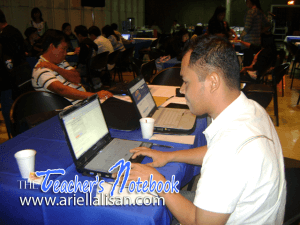THE WEB has been very helpful for me since I started teaching more than three years ago. Not only does it provide me with content I can use for classroom instruction, it allows me to extend the learning process even beyond school hours — and even after my students finish their course.

How do I integrate the internet into my teaching? As Elizabeth Barrett Browning would say, let me count the ways.
- Online Research – The internet is a vast resource for learning, if only one knows how to determine accurate content from rubbish. I enrich the knowledge I get from textbooks with information from the Net. I join online communities where physics teachers from all over the world. My favorites are PhET, MIT Open Courseware, ePals, and Teachnet. I also ask the students to do online research on certain topics sometimes for enrichment.
- File Storage and Sharing – I usually prepare PowerPoint presentations for pre-activity or post-activity discussions. I upload these files in our e-group where students can retrieve them after class or whenever they go online. In the classroom, they can freely participate in discussions and need not worry about copying what’s written on the slides. I encourage them to jot down other relevant information that surface during the discussion. though.
- Distance Learning – Whenever I am sent to an out-of-town trainings, the web enables me to still have contact time with my class. I send them activities via our e-group, and the output are either written on paper, uploaded back to our e-group, or posted on the students’ blogs, which can check even when I am on the go. All I need is a laptop and internet connection via wi-fi or wireless broadband.
In the 3rd National Science and Mathematics Summit, the teachers were taught to make blogs and to use blogging as an avenue for teaching. What it failed to discuss — which, I think, is of greater importance — is a set of guidelines to ensure effective learning. We could not simply post content online for the students to read or link to sites that offer simulations and then assume that the students can learn after performing such activities.
Now, here are the personal guidelines I follow in designing online activities for my students:
- Set clear objectives – It is given that when a teacher prepares his lesson plan, he must prepare a clear set of objectives that are attainable at the end of the lesson. It is not much different for online learning activities. The teacher should have a clear picture of what he wants his students to do and must foresee what possible generalizations the students might arrive at after performing the online activity.
- Design varied assessment tools – Assessing what the students understand before, during, and after the activity is of great importance. Simple essay questions, multiple choice questions, or asking students to make predictions before the conduct of the activity would give the teacher a look at the current understanding of the students. Comprehension checks during the conduct of the activity would given the teachers an idea of the students are on the right track. Authentic assessment of performance-based tasks would also be helpful. A summative test at the end could be a tool for deciding whether the activity is effective or not.
- Encourage Collaborative Work – Two heads are better than one, you know that. It would be a lot better if students work together because they can hep each other. More questions will surface. And most importantly, it humanizes the use of technology. The online activity should not isolate the students nor replace the teacher. One of the speakers presented a picture of ICT integration with the teacher just sitting in one corner and the students doing activities in front of the computer. Some teachers even thought of not coming to class anymore; they’d just sit in front of their computers and give activities to students. There should still be teacher-student, student-student interactions.
- Encourage Inquiry – The sample lesson plan in a blog presented by the speaker only provided links to resource materials without questions that will guide them on what to observe or what significant lessons can be learned in those sites. It is very important that the students know what to look for before doing an activity so that they can take note of the important concepts they have to learn. This could be possible by providing them with guide questions, which are open ended. Furthermore, the students should be encouraged to ask more questions aside from those that they were given. This way, we make the most out of the simulations, videos, or other interactive content we ask them to access.
- Respect Intellectual Property Rights – We should avoid plagiarism. We want our students to generate their own content, we should also do the same. Do not upload videos, photos, or other that you did not create without acknowledging the source. By providing link to the site where you obtained your lesson materials, you are already acknowledging your source. That simple. Bottomline is do not claim ownership for content you did not generate.
Those are the important points I take note of when I design activities for my students. They may not cover all the important considerations, but at least, they give me a clear idea of what I am doing and why I am doing it. ICT integration does not only mean making use of technology in teaching but making sure that they effectively facilitate learning.






